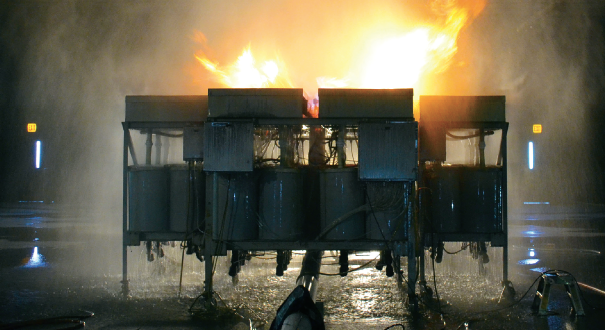Can ESFR Sprinklers Be Used?
Historically if you wanted to use early suppression fast resonse (ESFR) sprinklers but had solid shelving, you were out of luck (go directly to jail – do not pass go – do not collect $200). Up until the 2010 edition of NFPA 13, Standard for the Installation of Sprinkler Systems, it explicitly stated that ESFR could not be used with solid shelving. The same is true for control mode specific application (CMSA). That changed starting with the 2013 edition. Additionally, the guidance for the protection of solid shelving with control mode density application (CMDA) has evolved, though you’d never know it by reading just the individual paragraph that covers it. Let’s start with a brief discussion of the path in the standard by first looking at the old criteria since knowing the history helps if one needs to explain the change. As a side note, I find it amusing that the criteria between the different sections are slightly different for no reason (other than it’s the result of a beast with multiple parts moving at a rapid rate of speed during the development phase). In looking at the 2010 edition of NFPA 13, it explicitly states in multiple locations that CMSA and ESFR sprinklers can be applied only to racks “without solid shelves.” Before delving into the change, let’s take a minute to look at what is meant by solid shelves.
Historically, this issue was exclusively about control mode density area protection (aka spray sprinklers). So we’ll quickly look at definitions and the prior text on the current sections 16.1.6 and 17.1.5. This is critical since there has been a monumental shift in when an assembly is considered solid shelving. In the beginning, this classification applied to the features or components of the bare rack assembly. As the definition from the 1998 edition of NFPA 231C, Standard For Rack Storage Of Materials, stated, “Solid, slatted, and other types of shelving within the rack that obstructs penetration down through the rack.” It’s also interesting that the requirement for in-rack sprinklers applied only if both transverse and longitudinal flues were blocked.
The 1999 edition of NFPA 13 retained the same criteria when it incorporated the storage criteria from the NFPA 231 family of standards. The 2002 edition of NFPA 13, deleted the reference to both flues and introduced the 20 ft2 and 64 ft2 area variables. The 2007 edition remained the same. Actually there was a big change but it was blocked at the NFPA annual technical session so the text reverted to the 2002 edition. Surprisingly, it took several cycles to get back to where the technical committee attempted to go in 2007. The issue of defining solid shelves was not the focus floor action, but was affected as collateral damage. The 2010 edition took half a step toward the end result by adding a definition for rack shelf area that included the load blocking the openings. It also added a definition for solid shelf rack that identified the components of the rack itself (effectively a repeat of what was and still is in the definition for solid shelving). It took a bigger step backwards by changing the title of 16.1.6 and 17.1.5 to solid shelf rack. At this point, the classification is explicitly determined by the components of the rack assembly and although defined the phrase “rack shelf area” is not really used within the standard. Solid shelf rack references shelf area but just to indicate openings in said area. The committee assumed it had clarified this issue as indicated by the summary of changes in the front of NFPA 13 stating, “Changes to rack storage in this edition include a new method to calculate the rack shelf area.” The 2013 edition saw no changes. For the 2016 edition it was realized the intent had not been accomplished. The definition of solid shelving was changed to include “or by the placement of loads that block openings that would otherwise serve as the required flue spaces.” The titles of sections 16.1.6 and 17.1.5 were changed back to solid shelving. There is now no ambiguity that it is not just what the empty rack assembly looks like but what the operational rack looks like. This really is not a surprise if you think back to the old definition in the 1998 edition of NFPA 231C where it said “ … that obstructs penetration down through the rack … .” As a side note, it’s actually a two-way street whereby it’s not just the ability of the water to penetrate downward but also for the heat to go upwards and activate the sprinklers in a timely manner.
Let’s now look at the shift regarding ESFR and CMSA systems. In the 2013 edition section 16.2.3.2 for ESFR protection for storage up to 25 ft deleted the restriction on rack storage involving solid shelves. A new section was also added, “16.2.3.2 ESFR sprinklers shall not be permitted to protect storage on solid shelf racks unless the solid shelf racks are protected with in-rack sprinklers in accordance with 16.1.6.” The same change was made in Chapter 17, but for storage greater than 25 ft. No ambiguity here. The problem, though, is that only about 15 percent of the applicable criteria was changed. The other 85 percent (such as the summary tables for these sections, Chapter 16 for storage greater than 25 ft, Chapter 17 for storage less than 25 ft, and all the CMSA sections) retained the old text allowing its use only without shelves. That might not give you a lot of confidence but the writing is on the wall. This was all cleaned up in the 2016 edition. All four sections for CMSA now say, “CMSA sprinklers shall not be permitted to protect storage on solid shelf racks unless the solid shelf racks are protected with in-rack sprinklers in accordance with 16.1.6” (or 17.1.5). For ESFR, the 2013 edition text for sections 16.2.3.2 and 17.3.3.1.1 remained and was added to the other two sections. In order to maintain the tradition of being consistently inconsistent, though, sections 16.3.2 and 17.2.3 applied a slightly different format. Instead of deleting the old restricting text, it was modified to reference the new allowance so it reads, “17.2.3.1.1 ESFR protection as defined shall not apply to the following: (1) Rack storage involving solid shelves, except as permitted by 17.2.3.1.2.” As a final item, let’s look at where in-rack sprinklers are located when solid shelving is present. The guidance is obvious when all the tiers are obstructed. The 2016 edition provided new guidance on what to do when only a portion of the rack has solid shelves (See Figure 1).

New text in both Chapters 16 and 17 (only Chapter 16 is shown) says:
“16.1.6.7 Where solid shelves obstruct only a portion of the rack, in-rack sprinklers shall be installed horizontally, within the flue a minimum of 4 ft (1.2 m) beyond the end of the solid shelf, and vertically as follows:
- In accordance with 17.1.5.1 and 17.1.5.2 for CMDA sprinklers
- Beneath all tiers under the highest solid shelf for CMSA and ESFR sprinklers”
Additionally, this information was repeated (with a slightly different format) in all eight CMSA and ESFR sections with the following text:
“Where solid shelves are used, in-rack sprinklers shall be installed in every level below the highest solid shelf.”
Unfortunately, no changes were made to the age-old text on CMDA that still says, “Where solid shelving in single-, double-, and multiple- row racks exceeds 64 ft2 (5.9 m2) in area or where the levels of storage exceed 6 ft (1.8 m), sprinklers shall be installed at the ceiling and below each level of shelving.” The old text when the solid shelving is less than 64 ft2 still states, “… sprinklers shall not be required below every shelf….” This is nice and clean when every tier has solid shelving, but it is ambiguous when only portions are obstructed. This issue was discussed during the committee meeting and the intent is that for CMDA, that in-racks should be installed just beneath the individual tiers with solid shelving. We can easily see this for 16.1.6.2 and 17.1.5.2 by defining shelving as solid shelving. Fixing 16.1.6.1 is not as easy. The main proof that this is, indeed, the intent is that CMSA and ESFR would not have explicitly identified that for them, every tier beneath the highest solid shelf requires in-rack sprinklers. It would have simply been stated as a general requirement. Let’s talk a little bit about why there’s a difference. Ceiling-only protection with CMSA and ESFR can be used for very aggressive fires. Ceiling-only protection for CMDA doesn’t fall in this category. When the fire potential can be aggressive, in-rack sprinklers are required. When a solid shelf is present, the additional in-rack sprinklers are being added to the other required in-racks. As such, a single tier of in-rack sprinklers, combined with a barrier, is considered to provide equivalent protection for the portion of the rack beneath it as that provided by ceiling only CMDA sprinklers for the same open rack.
It’s obvious that the technical committee still has some minor refinements to complete on this issue. It’s also obvious that the beast will always be moving at a rapid pace but with the overdue clean up/reformatting taking place this cycle (that seems to occur every 10 years or so), the number of moving parts has increased greatly.
 ABOUT THE AUTHOR: Roland Huggins, P.E. is the vice president of engineering and technical services for AFSA. He is a graduate of the University of Maryland and a member of the NFPA. Huggins has served on the NFPA Standards Council and is a member of multiple NFPA technical committees, including NFPA 13, NFPA 25, and NFPA 5000 (Building Code). NFPA activities include participating on the editing of the Sprinkler Handbook and Fire Protection Handbook. Other national activities involve the NFPA Research Foundation, UL Standard Technical Panels, and NICET. Huggins is a veteran.
ABOUT THE AUTHOR: Roland Huggins, P.E. is the vice president of engineering and technical services for AFSA. He is a graduate of the University of Maryland and a member of the NFPA. Huggins has served on the NFPA Standards Council and is a member of multiple NFPA technical committees, including NFPA 13, NFPA 25, and NFPA 5000 (Building Code). NFPA activities include participating on the editing of the Sprinkler Handbook and Fire Protection Handbook. Other national activities involve the NFPA Research Foundation, UL Standard Technical Panels, and NICET. Huggins is a veteran.
IMPORTANT NOTICE: The article and its content is not a Formal Interpretation issued pursuant to NFPA Regulations. Any opinion expressed is the personal opinion of the author and presenter and does not necessarily present the official position of the NFPA and its Technical Committee.
 Sprinkler Age A Publication of the American Fire Sprinkler Association
Sprinkler Age A Publication of the American Fire Sprinkler Association
